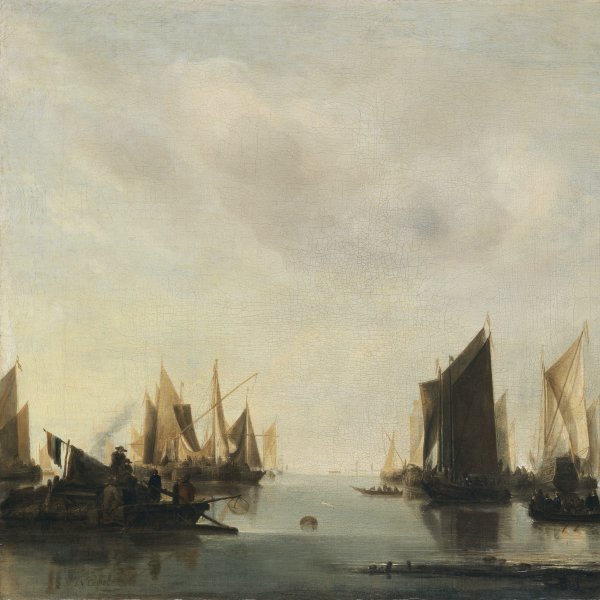Winter Landscape
Oil on panel.
41 x 42.2 cm
Museo Nacional Thyssen-Bornemisza, Madrid
Inv. no.
80
(1969.5
)
ROOM 28
Level 2
Permanent Collection
In addition to the marine views on which he primarily focused throughout his career, Jan van de Cappelle executed winter landscapes that allowed him to experiment with atmospheric phenomena, according to Valentiner. The artist painted frozen expanses of water such as canals and rivers with trees and buildings on each bank, animating these scenes with small figures playing sports and games, talking or walking along the frozen white ground. These areas of snow and ice allowed the artist to study and depict a wide range of pink and silver lights and reflections cast by the sky. Jan van de Cappelle was familiar with compositions of this type painted by artists of previous generations such as Hendrick Avercamp and Esaias van de Velde, and also bore in mind the work of Aert van der Neer whom he surpassed in compositional organisation and the quality of the atmospheric effects.
Winter Landscape is structured around a frozen river in the centre that spreads out to the lower edge of the panel where the artist has placed a number of figures. The spatial recession is achieved through the natural course of the river, which is framed on its banks by houses and bare trees in the foreground and middleground and through a wooden bridge slightly further back that leads the eye into the background and towards the area of bushes and trees on the left. The harshness of the winter climate with its cold wind is conveyed by the movement of the figures’ clothes. Some of these figures are enjoying winter sports and games including those on the right with a man skating, a boy sliding on the ice in a miniature boat and a group playing colf. The blue sky at the upper edge is starting to be rapidly covered over by dense patches of clouds that suggest rain and dampness. The composition is typical of Van de Cappelle as he frequently used the motif of a river receding into the distance and framed on either side by trees and bushes with boats frozen into the ice. The artist painted around twenty winter landscapes of which the most successful are those dating from between 1652 and 1653 in which the effects of the weather and atmosphere are the true protagonists.
Stechow referred to the influence of these works by Cappelle on the production of Jan van Kessel. Winter Landscape by that artist (private collection) is an almost exact copy of the present panel. It omits the figures on the right and modifies the middle distance and the background as well as the viewpoint, with the scene presented from further away.
This panel was in the collection of Nicolaas Doekscheer and was auctioned in Amsterdam following his death in 1789. It appeared on the art market various times and was in collections in Amsterdam, Glasgow, Richmond and Oldenzaal, among other places. It was acquired for the Thyssen-Bornemisza collection in 1969 via the Cramer gallery in The Hague.
Mar Borobia
Winter Landscape is structured around a frozen river in the centre that spreads out to the lower edge of the panel where the artist has placed a number of figures. The spatial recession is achieved through the natural course of the river, which is framed on its banks by houses and bare trees in the foreground and middleground and through a wooden bridge slightly further back that leads the eye into the background and towards the area of bushes and trees on the left. The harshness of the winter climate with its cold wind is conveyed by the movement of the figures’ clothes. Some of these figures are enjoying winter sports and games including those on the right with a man skating, a boy sliding on the ice in a miniature boat and a group playing colf. The blue sky at the upper edge is starting to be rapidly covered over by dense patches of clouds that suggest rain and dampness. The composition is typical of Van de Cappelle as he frequently used the motif of a river receding into the distance and framed on either side by trees and bushes with boats frozen into the ice. The artist painted around twenty winter landscapes of which the most successful are those dating from between 1652 and 1653 in which the effects of the weather and atmosphere are the true protagonists.
Stechow referred to the influence of these works by Cappelle on the production of Jan van Kessel. Winter Landscape by that artist (private collection) is an almost exact copy of the present panel. It omits the figures on the right and modifies the middle distance and the background as well as the viewpoint, with the scene presented from further away.
This panel was in the collection of Nicolaas Doekscheer and was auctioned in Amsterdam following his death in 1789. It appeared on the art market various times and was in collections in Amsterdam, Glasgow, Richmond and Oldenzaal, among other places. It was acquired for the Thyssen-Bornemisza collection in 1969 via the Cramer gallery in The Hague.
Mar Borobia









